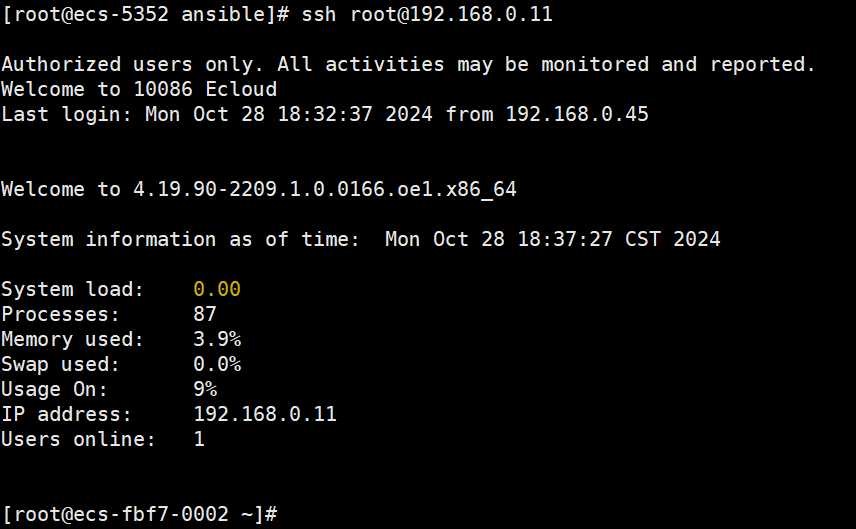ansible开局配置-openEuler
ansible干啥用的就不多介绍了,这篇文章主要在说ansible的安装、开局配置、免密登录。
ansible安装
- 查看系统版本
cat /etc/openEuler-latest
输出内容如下:
openeulerversion=openEuler-24.03-LTS
compiletime=2024-05-27-21-31-28
gccversion=12.3.1-30.oe2403
kernelversion=6.6.0-28.0.0.34.oe2403
openjdkversion=1.8.0.412.b08-5.oe2403
- 清除软件库缓存
dnf clean all
- 建议软件库缓存
dnf makecache
- 安装epel-release软件仓
- 下载对应版本epel-release的软件仓库
# 不同系统版本需要安装不同的epel-release
wget https://mirrors.aliyun.com/repo/epel-testing.repo
2. 重新建立软件库索引
mv epel-testing.repo /etc/yum.repo.d/
dnf clean all
dnf makecache
- 安装ansible
dnf -y install ansible
等待安装完成即可
开局配置
- 常用文件介绍
/etc/ansible/hosts ## 用于存放需要批量管理的主机IP或主机名称
/etc/ansible/ansible.cfg ## 该文件为ansible的主要配置文件
- 添加主机到ansible
192.168.0.10 ansible_ssh_pass=主机密码 ansible_ssh_user=主机账号
192.168.0.11 ansible_ssh_pass=主机密码 ansible_ssh_user=主机账号
192.168.0.12 ansible_ssh_pass=主机密码 ansible_ssh_user=主机账号
ansible_ssh_pass:远程主机登录密码
ansible_ssh_user:远程主机登录账号
- 远程执行ping命令,会发现执行报错
ansible all -m ping
输出内容如下:
192.168.0.10 | FAILED! => {
"msg": "Using a SSH password instead of a key is not possible because Host Key checking is enabled and sshpass does not support
this. Please add this host's fingerprint to your known_hosts file to
manage this host."}
192.168.0.11 | FAILED! => {
"msg": "Using a SSH password instead of a key is not possible because Host Key checking is enabled and sshpass does not support
this. Please add this host's fingerprint to your known_hosts file to
manage this host."}
192.168.0.12 | FAILED! => {
"msg": "Using a SSH password instead of a key is not possible because Host Key checking is enabled and sshpass does not support
this. Please add this host's fingerprint to your known_hosts file to
manage this host."}
出现这个问题主要是因为ansible默认是没有开启账号密码登录的,默认采用证书登录,只需要在配置文件中把证书登录关闭就可以执行成功了。
进入/etc/ansible/ansible.cfg文件,将host_key_checking = False取消注释或者增加该内容即可
再次重新执行就不会有问题了,成功后输出内容如下
192.168.0.11 | SUCCESS => {
"ansible_facts": { "discovered_interpreter_python": "/usr/bin/python" }, "changed": false, "ping": "pong"
}
192.168.0.10 | SUCCESS => {
"ansible_facts": { "discovered_interpreter_python": "/usr/bin/python" }, "changed": false, "ping": "pong"
}
192.168.0.12 | SUCCESS => {
"ansible_facts": { "discovered_interpreter_python": "/usr/bin/python" }, "changed": false, "ping": "pong"
}
配置免密登录
- 生成密钥
ssh-keygen
一路回车即可,输出内容如下:
Generating public/private rsa key pair.
Enter file in which to save the key (/root/.ssh/id_rsa):
Enter passphrase (empty for no passphrase):
Enter same passphrase again:
Your identification has been saved in /root/.ssh/id_rsa
Your public key has been saved in /root/.ssh/id_rsa.pub
The key fingerprint is:
SHA256:+RGyyNnrIHOLllk+e2hpNyTmxjBZkMY5vvDmTGuEh5g root@ecs-5352
The key's randomart image is:
+---[RSA 3072]----+
| . o |
| B |
| o o . . |
| . ...+ + . |
| o = ++ S . |
|E o @ + .o . |
| Bo%o=. . |
| O=@++ |
| o.+o=.. |
+----[SHA256]-----+
- 编写playbook脚本文件
- hosts: # 主机组
remote_user: # 用户名
tasks:
- name: push ansible key
authorized_key: user=root key="{{ lookup('file' ,'密钥存放位置')}}" state=present
示例:
- hosts: all
remote_user: root
tasks:
- name: push ansible key
authorized_key: user=root key="{{ lookup('file' ,'/root/.ssh/id_rsa.pub')}}" state=present
- 执行playbook脚本文件
ansible-playbook push_key.yml
输出结果如下表示执行成功:
[root@ecs-5352 yml]# ansible-playbook push_key.yml
PLAY [all]
TASK [Gathering Facts]
ok: [192.168.0.10]
ok: [192.168.0.12]
ok: [192.168.0.11]
TASK [push ansible key]
changed: [192.168.0.10]
changed: [192.168.0.12]
changed: [192.168.0.11]
PLAY RECAP
192.168.0.10 : ok=2 changed=1 unreachable=0 failed=0 skipped=0 rescued=0 ignored=0
192.168.0.11 : ok=2 changed=1 unreachable=0 failed=0 skipped=0 rescued=0 ignored=0
192.168.0.12 : ok=2 changed=1 unreachable=0 failed=0 skipped=0 rescued=0 ignored=0
- 测试是否可以免密
- 将ansible.cfg配置文件中的host_key_checking = False注释掉
2. 删除hosts文件主机后面的用户名和密码
3. 测试执行ping命令
ansible all -m ping
输出结果如下:
192.168.0.10 | SUCCESS => {
"ansible_facts": { "discovered_interpreter_python": "/usr/bin/python" }, "changed": false, "ping": "pong"
}
192.168.0.12 | SUCCESS => {
"ansible_facts": { "discovered_interpreter_python": "/usr/bin/python" }, "changed": false, "ping": "pong"
}
192.168.0.11 | SUCCESS => {
"ansible_facts": { "discovered_interpreter_python": "/usr/bin/python" }, "changed": false, "ping": "pong"
}
- 再次测试
直接在ansible主机上,使用ssh命令测试是否可以免密登录
ssh root@192.168.0.11
无需输入密码即可登录成功
ansible开局配置-openEuler的更多相关文章
- Ansible自动化配置详解
第1章 Ansible基本概述 1.1 ansible是一个配置管理系统configuration management system, 你只需要可以使用ssh访问你的服务器或设备就行. 1.安装软件 ...
- Ansible安装配置及命令使用详解
Ansible和saltstack目前市面上一些其它的项目管理工具有很大的不同,它的设计初衷就是为了更方便.快捷的进行配置管理.它易于安装和使用.语法也非常简单易学.你可以用Ansible将平常复杂的 ...
- Ansible 使用配置
1.配置 /etc/ansible/hosts 文件,添加被管控主机ip #vim /etc/ansible/hosts 文件末尾添加组[group1]和被管控主机的IP [group1] 192 ...
- CentOS 9 开局配置
CentOS 9 开局配置 CentOS 9 发布有几年了,一直没有尝试使用,CentOS 9 有一些变动. 查看系统基础信息 # 查看系统基础信息 [root@chenby ~]# neofetch ...
- Ansible安装配置Nginx
一.思路 现在一台机器上编译安装好nginx.打包,然后在用ansible去下发 cd /etc/ansible 进入ansible配置文件目录 mkdir roles/{common,install ...
- Ansible安装配置及使用
一.Ansible特点 1.不需要安装客户端,通过sshd通信 2.基于模块工作,模块可以由任何序言开发 3.不仅支持命令行使用模块,也支持编写yaml格式的playbook 4.支持sudo 5.有 ...
- Ansible安装配置
Ansible工具的安装与配置 Ansible基于SSH,不需要在远程端安装任何软件,只需要在管理端安装ansible及其组件即可. Ansible使用前提是已配置ssh密钥免登陆. 一.安装组件: ...
- Ansible(二) - 配置及命令简介
Ⅰ. Ansible Inventory Hosts文件配置 # mkdir /etc/ansible # touch /etc/ansible/hosts # cat /etc/hosts 127. ...
- 1、Ansible安装配置
ansible介绍: Ansible是一款基于Python开发的自动化运维工具,主要是实现批量系统配置.批量程序部署.批量运行命令.批量执行任务等等诸多功能.Ansible是一款灵活的开源工具,能够很 ...
- ansible常用配置
1.什么是Ansible 部署参考连接:http://www.ansible.com.cn/ ansible是新出现的自动化运维工具,基于Python开发,集合了众多运维工具(puppet.cfeng ...
随机推荐
- k8s单机部署
一.环境 64位centos 二.安装 (1)关闭防火墙 systemctl stop firewalld systemctl disable firewalld (2)安装etcd与kubernet ...
- Oracle数据库自动备份
1.bat脚本 格式为ANSI格式 set CURDATE=%date:~0,4%%date:~5,2%%date:~8,2% set CURMON=%date:~0,4%%date:~5,2% se ...
- 微信小程序开发工具怎样支持xdebug调试
在做PHP项目时候用xdebug进行调试,如果使用浏览器我一般直接 Xdebug Helper 浏览器插件.配合PHPSTORM进行调试. 微信小程序并不支持cookies,因此需要另想办法,可以在微 ...
- Java核心知识体系9-并发与多线程:线程基础
Java系列 Java核心知识体系1:泛型机制详解 Java核心知识体系2:注解机制详解 Java核心知识体系3:异常机制详解 Java核心知识体系4:AOP原理和切面应用 Java核心知识体系5:反 ...
- R-Adapter:零样本模型微调新突破,提升鲁棒性与泛化能力 | ECCV 2024
大规模图像-文本预训练模型实现了零样本分类,并在不同数据分布下提供了一致的准确性.然而,这些模型在下游任务中通常需要微调优化,这会降低对于超出分布范围的数据的泛化能力,并需要大量的计算资源.论文提出新 ...
- zabbix-server无法启动
部署:Zabbix-(1)安装 - xiao智 - 博客园 (cnblogs.com) 故障现象: 监控界面状态为 "否" 1.服务状态果然报错了 ,报错提示是被退出的 2.net ...
- 即构 UIKits 重磅发布!高效开发与自定义UI兼备,打造互动场景新标杆
即构UIKits上线,新一代场景化实时互动SDK! 即构科技发布了首款面向中小团队的整合型实时互动产品UIKits , 基于场景化最佳实践,整合RTC.IM.直播.美颜等多款产品,打造了音视频通话UI ...
- Angular 18+ 高级教程 – Angular CLI
前言 这篇会列出我开发中常用的 command. 并给予一些简单的说明 Command Format 先了解一下几个简单的 command 格式: 缩写 shortform 这个是完整版 ng gen ...
- ASP.NET Core C# 反射 & 表达式树 (第二篇)
前言 上一篇讲到了各种反射的操作方式, 这一篇主要说说如何找到类型. Type Information 在找类型的时候, 除了依据简单的 string 以外, 还会用到很多类型属性来做判断. 比如它是 ...
- 【原创】解决NasCab掉进程,NasCab进程维护
最近对象吐槽家里服务器又连不上,看不了考研视频了. 我掏出手机一试,确实连不上.家里的服务器是Win11平台,用NasCab管理的视频文件,然后通过frpc做的内网穿透. 我们在外面的图书馆,连不上无 ...




